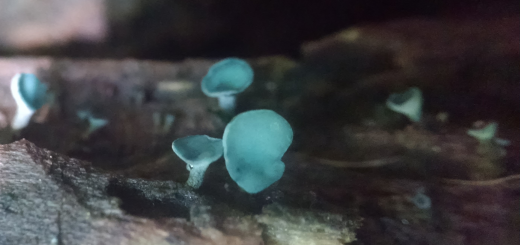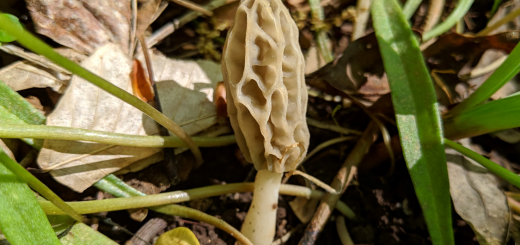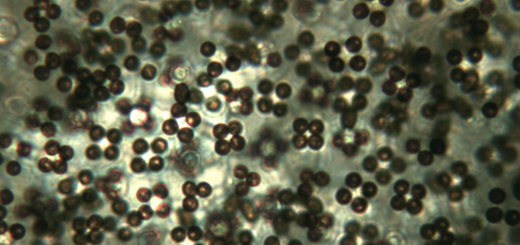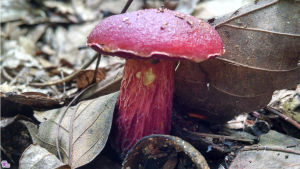#123: The Candy Caps
Mushrooms come in some surprising flavors. Probably the most unusual flavors are found in the group of mushrooms known as “Candy Caps.” These mushrooms taste/smell like maple syrup, butterscotch, camphor, burnt sugar, or curry. Thanks to their pleasant odors, these edible mushrooms are usually used in dessert dishes! I recently had the opportunity to taste some Candy Cap ice cream and was astounded by the intense maple syrup flavor provided by the mushrooms!
There are three (and possibly more) species of Candy Caps in North America: Lactarius rubidus, L. fragilis, and L. camphoratus. Michael Kuo – the author of MushroomExpert.com – suspects that DNA studies will reveal more species hidden under these names because of wide variations in physical features and mycorrhizal partner trees. All three of these species are edible and produce a strong, maple syrup-like aroma. One of the interesting things about these mushrooms is that their unique odor is only produced after the mushrooms are dried. When fresh, they may have a faint maple smell, but this is likely to go unnoticed. After drying, however, their aroma is strong enough to fill large rooms for days. Herbarium collections of L. fragilis have been found to retain their smell for over 60 years!
Candy Caps are little brown mushrooms (LBMs), so they are easily confused with lots of other mushrooms, especially if you are a novice identifier. One way to cut down the possibilities considerably is to check the consistency of the stipe. Candy Caps belong to the genus Lactarius, which is part of the family Russulaceae. This family is characterized by crumbly flesh. When hunting for Candy Caps, it is recommended that you forego using a knife. Normally, when collecting for the table, you should use a knife to cut the mushroom off just above the base. This gets rid of the dirt attached to the base and leaves the underground mycelium intact. With Candy Caps, however, you should use your fingers to break off the end of the stipe. If it is in the Russulaceae, the stem should break crisply like a stick of chalk. Other LBMs have stipes that bend or fracture irregularly and are NOT crumbly or chalk-like.
If you are unsure whether or not the mushroom’s flesh has a chalk-like texture, you can check the spore print color. Candy Caps should have a whitish to creamy to pale yellow spore print. Many LBMs (including the deadly Galerina autumnalis, which has a rusty spore print) have black, brown, or pink spore prints.
To identify it down to the genus Lactarius, you can make a small slice in the mushroom’s gills. Lactarius mushrooms should exude a milky latex from this cut. Of course, older mushrooms sometimes simply refuse to release any latex, which can hamper identification efforts. Candy Caps should have a watery latex that looks somewhat like skim milk (usually watered down when older). Another key factor for identifying Lactarius species is the color the latex leaves on the mushroom or on paper after it dries. The latex from Candy Caps should dry clear (or perhaps slightly pinkish) and should not change the color of the mushroom’s tissues. This feature sets them apart from many look-alike Lactarius species.
The Candy Caps’ pileus color and pileus texture also set them apart from other members of the Lactarius genus. Candy Caps have a reddish-brown to orangish-brown cap color. Its color may be darker toward the center of the cap, but the cap will not feature alternating rings of color. When fresh, the caps’ texture is dry to moist, rather than shiny, sticky, slippery, or glossy. Discerning the true texture of the cap can get a little complicated if it is wet. In that case, you will have to let the mushroom dry out a little but not so much that it starts shriveling up. Candy Caps usually have a slightly wrinkled, bumpy, or lined pileus, especially around the edges as the mushroom ages.
Other features of Candy Caps that may not be useful for identification are as follows. The pileus is convex when young but expands to become flat, often developing a central depression. There is usually a small bump (“papilla” or “umbo”) at the center of the cap. Underneath the cap, the gills are attached to the stipe and often begin to run down it. The gills are whitish with pink, orange, or yellow tones. As the mushrooms age, the gills develop darker colors and stains (but not when sliced or from dried latex) to become reddish to cinnamon. The stipe is smooth and undecorated except for fuzz or a few hairs at the base. It maintains roughly the same thickness all the way down and is colored about like the cap, though often slightly paler towards the top.
Wikipedia (see link below) has a nice chart comparing the differences between Candy Cap species, although it doesn’t quite match up with information from other sources. The physical features that most readily differentiate species of Candy Caps are: size, the intensity of the pileus color, the color of the gills, and the ornamentation of the spores. L. camphoratus is 1-4cm across at the pileus, 1.5-6cm tall, and has a stipe that is roughly 1cm thick. It has the darkest pileus, gills with pinkish tones that become reddish to cinnamon, and spores dotted with mostly unconnected bumps (“warts”). L. rubidus is the largest Candy Cap, with a cap that is 2-8cm wide and a stipe that is 2-7cm long and about 1.5cm thick. This mushroom is characterized by a deep pileus color, gills with orange tones that discolor cinnamon, and spores that feature broken ridges (“partially reticulate”). L. fragilis is about the same size as L. camphoratus, displays the lightest pileus, has yellow tones on the gills, and produces spores with an unbroken network of ridges (“reticulate”).
Like all Lactarius species, Candy Caps are mycorrhizal. L. fragilis and L. camphoratus can be found under a wide variety of hardwoods and conifers. L. rubidus is usually found under Coast Live Oak, Tanoak, and Douglas-Fir. This habitat usually distinguishes them from most other LBMs (such as G. autumnalis) that are found fruiting on wood. Sometimes, however, Candy Caps can be found growing on wood covered with moss or humus. On the flip side, some wood-decomposing LBMs can appear terrestrial when growing from buried wood. As a result, you always have to be vigilant to make sure that you have correctly identified the mushrooms’ substrate and double-check that each mushroom in the area is indeed the same species.
L. camphoratus is the most widely distributed species (although this may be because the current description actually includes multiple species) and is native to Europe, Asia, and Eastern North America. L. fragilis is limited to the Southeastern United States while L. rubidus can be found only along the West Coast. Unfortunately for those of you in the Central and Northern parts of North America, there are no species of Candy Cap that grow in your area. Candy Caps seem to have a preference for fruiting in disturbed areas, like beside trails and roadways. This is good news because it makes these easily overlooked mushrooms a bit less difficult to find.
One further species is sometimes included in the Candy Caps: L. rufulus. This species, although edible, does not have as intense of a maple syrup odor when dried and may be slightly acrid. As a result, it is less desirable than the other three Candy Caps. L. rufulus resembles L. rubidus but is larger (up to 10cm wide and 12cm tall), has pink and yellow tones in its gills, and is found under oaks in California, Arizona, and Mexico. It also tends to grow in dense clusters while the other Candy Cap species are solitary.
So how do Candy Caps get their distinctive smell? It turns out that these little mushrooms make the same chemical that is found in artificial maple syrup! The story is a little more complicated than that, and it took a couple scientists nearly 30 years to figure it all out. Certain amino acids in the mushrooms react with each other during the drying process to produce a compound called quabalactone III. This molecule belongs to a class of molecules known as esters, which typically have strong and fragrant odors. However, to get the maple syrup smell, quabalactone III must react with water. This reaction produces sotolon, the chemical that flavors synthetic maple syrup. The interesting thing about this molecule is that it only smells like maple syrup when its concentration is low. At higher concentrations, it takes on a curry or fenugreek smell. This explains why some people report that the Candy Cap smells like curry. The same compound is actually responsible for both smells!
Unfortunately, Candy Caps sometimes misbehave. There are numerous reports of people experiencing a bitter flavor from Candy Caps. This could have a number of causes, including misidentification and collecting old or moldy specimens. However, it seems likely that some fresh, legitimate Candy Caps have a bitter flavor. This could indicate that certain populations of Candy Caps or as yet unidentified cryptic species in the Candy Cap cluster are prone to producing bitter compounds. As far as I know, there has not been any research done focusing on the bitterness problem. Tasting a little bit of each mushroom should help root out the bitter ones and any look-alikes hiding in your collection. To do this, put a tiny piece of the mushroom on your tongue for a few seconds before spitting it out. Other similar species of Lactarius have an acrid taste and can easily be separated from the mild-tasting (or bitter) Candy Caps by using this method.
Today, Candy Caps sell for between $12 and $15 an ounce online. The high price tag is due to the fact that these fungi are mycorrhizal and therefore cannot be cultivated. It is also rather difficult to pick large quantities of these mushrooms due to their small size. Luckily, the Candy Caps are quite potent and you don’t need very many to create a spectacular dish. Candy Caps are frequently used in ice cream, cookies, cakes, puddings, other desserts, breads, and even in meat dishes (particularly those with smoked meats). Certainly any dish you use them in will be one of the most unusual things you’ve ever made with mushrooms!
See Further:
http://www.mushroomexpert.com/lactarius_camphoratus.html
http://www.mushroomexpert.com/lactarius_rubidus.html
http://www.mykoweb.com/CAF/species/Lactarius_rubidus.html
http://www.mykoweb.com/articles/CandyCapComplex.html
http://botit.botany.wisc.edu/toms_fungi/oct2005.html
http://www.bayareamushrooms.org/mushroommonth/candy_cap.html
http://io9.gizmodo.com/chemists-discover-why-this-mushroom-tastes-like-maple-s-1648492868









![#011: Characteristics of Kingdom Fungi [Archived]](https://www.fungusfactfriday.com/wp-content/themes/hueman/assets/front/img/thumb-small-empty.png)


1 Response
[…] and poisonous species. The most popular edible milk mushrooms are L. volemus and the Candy Caps (FFF#123). L. volemus is eaten like a normal mushroom, while the Candy Caps have a strong maple syrup flavor […]